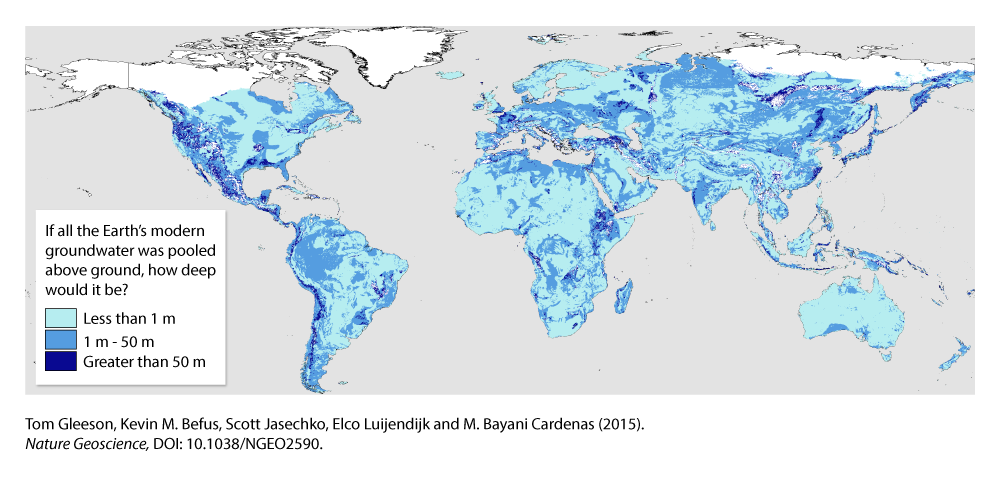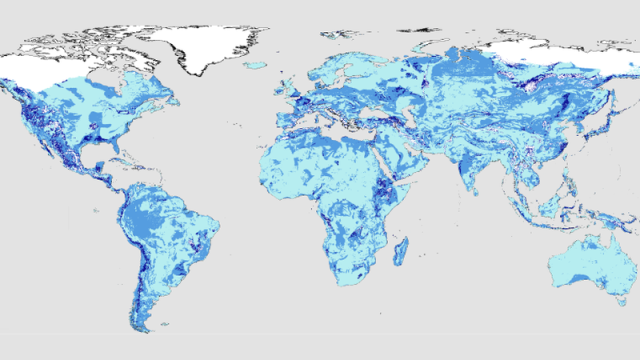Surprisingly, scientists know very little about the water that’s located beneath the Earth’s surface. To overcome this knowledge gap, an international team of researchers has put together a new global map showing where and in what quantities this precious resource is located.
To put this map together, the University of Victoria’s Tom Gleeson, along with colleagues from the University of Texas at Austin, the University of Gottingen, and the University of Calgary, analysed a host of datasets, including data from nearly a million watersheds and more than 40,000 groundwater models. It’s the first time that hydrologists have generated a data-driven estimate of the Earth’s total supply of groundwater. The details of the study can now be found at Nature Geoscience.
The researchers estimate that the Earth contains a total of 23 million cubic kilometres of total groundwater, of which 0.35 million cubic kilometres (1.52%) is younger than 50 years old. Much of this groundwater is located in subterranean aquifers, which are tapped by humans in regions where surface water isn’t readily available. Alarmingly, the study shows that about 6% of the groundwater in the upper 2km of the Earth’s landmass is renewable within a human lifetime.
“This has never been known before,” noted Gleeson in a release. “We already know that water levels in lots of aquifers are dropping. We’re using our groundwater resources too fast — faster than they’re being renewed.”
Importantly, hydrologists have to differentiate “old” from “modern” groundwater. Old groundwater is located deeper in the Earth, and is typically used as a water resource for agriculture and industry. It sometimes contains arsenic and uranium, and is often saltier than ocean water. Gleeson says that old water, which is briny and stagnant, should be considered a nonrenewable resource.
Modern water, on the other hand, is more plentiful, and it steadily “recharges.” But because it’s located closer to the surface and is more fast-moving, it’s more vulnerable to climate change and contamination. And as already noted, humans are consuming this water faster than can be replenished. A recent study found that a third of the world’s big groundwater basins are now in a state of “significant distress.”

Looking at the map, we can see that most of the world’s modern groundwater is located in tropical and mountain regions. Some of the largest deposits are in the Amazon Basin, the Congo, Indonesia, and in North and Central America along the Rockies and western cordillera. Not surprisingly, arid regions such as the Sahara are relatively low in groundwater. The northern latitudes are blank because satellite data doesn’t exist for these regions. But these areas are mostly under permafrost and contain little groundwater.
“Intuitively, we expect drier areas to have less young groundwater and more humid areas to have more, but before this study, all we had was intuition,” noted study co-author Kevin Befus from the University of Texas. “Now we have a quantitative estimate that we compared to geochemical observations.”
The next step for the researchers will be to understand how quickly we’re depleting both old and modern groundwater. As Gleeson noted in a 2010 study:
Groundwater extraction has facilitated significant social development and economic growth, enhanced food security and alleviated drought in many farming regions. But groundwater development has also depressed water tables, degraded ecosystems and led to the deterioration of groundwater quality, as well as to conflict among water users.
Sadly, climate change will only exacerbate the problem.
Read the entire study at Nature Geoscience: “The global volume and distribution of modern groundwater“.
